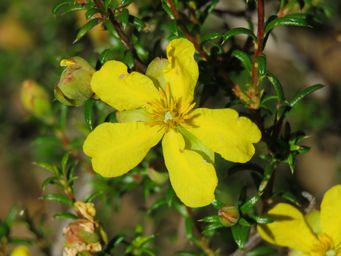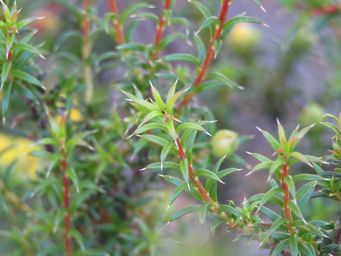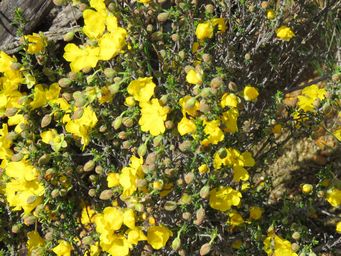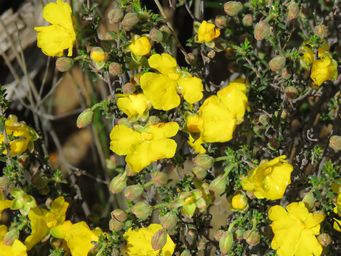Australia So Much to See
Yellow, five petals semi split or indented at the petal tip. Size of flowers and leaf shape varies with different species.



Hibbertia cuneiformis, Cutleaf Hibbertia
Yellow, five petals semi split, along stem. Fifteen to twenty-five stamens, groups in bunches
of five. Larger than most Hibbertia species, with clusters of elongated pointed leaves with two lesser points near the tip. Shrubs
can reach three metres in height. Some leaves can turn red.
Seen January to March, and can flower almost any time of year.
Albany
(above) and Karridale (at right), and found in coastal areas extending from Perth to Esperance


Hibbertia commutata
Yellow five petalled flowers of around 2.5 centimetres in diameter, with end of petal semi-split. Stamens
are in three groups. Hairy sepals as can be seen on buds, and some hairiness on these larger leaves.
August September




Hibbertia diamesogenos
A small yellow Hibbertia flowers of five semi-split petals, with stamens curved in one direction, on a bush
with elongated leaves which are slightly stippled in texture and terminate in a spine.
October
Tonebridge (Boyup Brook) and occurs
from north of Perth, through the South West and parts of the lower Great Southern regions, and further along the coastline near Esperance.





Hibbertia arcuata
Yellow, five slightly crinkled petals with a leave tip indent, and a ring of stamens with long anthers which turn
outwards. Foliage consists of narrow leaves, strongly recurved and terminating in a sharp spine. An upright shrub which
may grow to 1.3 metres. Stems may appear reddish brown.
August
Seen at Wilroy nature reserve and Tardun in the Greater
Geraldton Council area, and Latham in the Perenjori Shire, in the Mid West region of Western Australia. Found in scattered locations
through the Mid West and northern Wheatbelt plus a few Goldfields locations, in an area bounded by Meekatharra and Wyalkatchem, Mullewa
and Leonora.



Hibbertia eatoniae
Yellow, five petals semi split, with stamens all turned in the one direction. A low growing shrub reaching sixty
centimetres in height. Foliage consists of narrow leaves, curved towards the tip which terminates with a spine.
August
Merredin, Wheatbelt region, Western Australia, and found through the central eastern Wheatbelt and into the Goldfields
near Coolgardie.